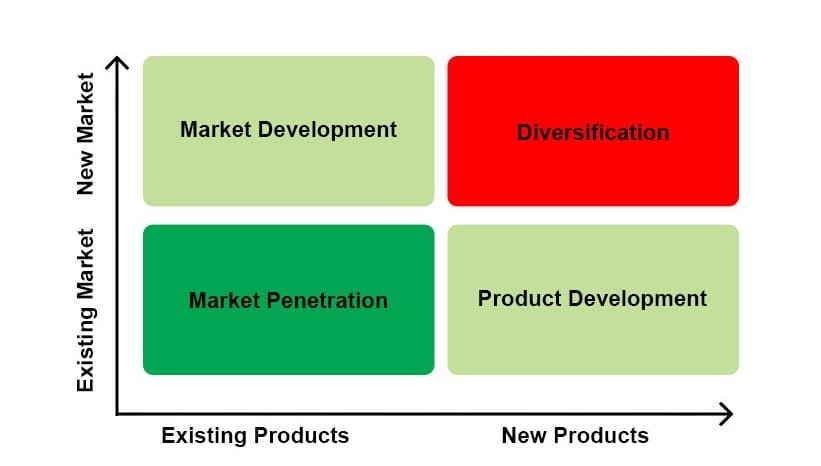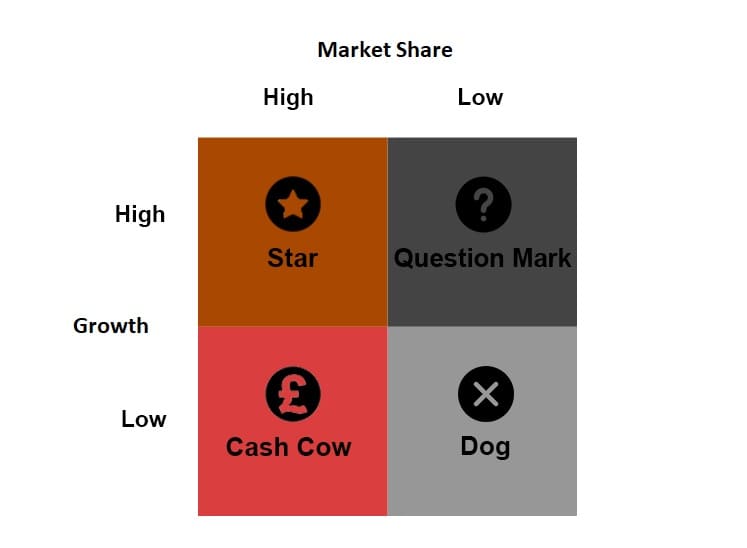Definition: A growth strategy helps an organization plan for expansion, enter a new market, or launch a new product portfolio. This strategy brings the organization more revenue and increases its presence in new or existing markets.
New product launches, diversification, strategic alliances, mergers, and acquisition are a few examples of growth strategies.
Types of Growth Strategies
According to the Ansoff Matrix, growth strategies can be classified into four categories:

- Product Development Strategy
- Market Development Strategy
- Market Penetration Strategy
- Diversification Strategy
Product Development Strategy: Here, businesses develop new products to grow the business in the existing market.
Market Development Strategy: With this strategy, businesses develop new customer bases, expand user bases, or enter a new market with existing products.
Market Penetration Strategy: In this case, businesses penetrate markets with different marketing tactics, such as giving discounts, lowering prices, bundling products, etc. They attempt to increase their market share in the existing market.
Diversification Strategy: This is the riskiest strategy of all. Here, businesses enter a new market or launch unique new products. Although it is the riskiest, if implemented well, it can also yield huge rewards to organizations.
Steps for Business Growth Strategy
- Select Area to Target Growth
- Conduct Research
- Set the Goals
- Develop the Plan
- Execute the Plan
- Collect Feedback & Modify Strategies
#1 – Select an Area to Target Growth
An organization must target a specific area for growth and strategy, whether that is entering a new market, launching a product in an existing market, implementing a merger or acquisition, increasing the sales, etc.
Each area has a specific strategy and requires different effort and skills. Businesses should target the area based on available resources, skills, and market conditions.
#2 – Conduct Research
Before setting the goal and planning the course of action, the business conducts market research to collect data. The market research can be through surveys, interviews with industry leaders, brainstorming with subject experts, or public feedback, among other things.
#3 – Set the Goals
After conducting the research and collecting the data, the business set its goal. Examples of strong goals are increasing sales or launching new products.
Goals provide clear direction to the organization, help develop plans, and motivate employees.
The goal must align with the organization’s long-term planning and strategic objective/mission.
#4 – Develop the Plan
This is the step where the business outlines and provides a detailed business growth strategy plan. This plan provides the exact actions necessary to achieve growth in the defined time frame.
This plan includes devising a budget, providing resource requirements, dividing tasks, and assigning roles & responsibilities.
#5 – Execute the Plan
This is the key step. Here, the organization executes the plan and carries out the activities outlined in the business growth plan.
#6 – Collect Feedback & Modify Strategies
Collecting feedback is important. Feedback lets businesses know if their strategy is working. If the strategy is not working, then it provides valuable information to help businesses modify their strategy and update their plan to reflect the market realities.
This step will make the growth strategy robust and help businesses achieve their goal.
Growth Strategy Framework
An organization should use the right growth strategy framework to grow its business. A growth strategy framework provides an organization with structured thinking and the right planning tool to proceed with growth planning.
A few popular growth strategy frameworks are as follows:
- The Ansoff Matrix
- BCG Growth-Share Matrix
- Porter’s Five Forces Model
- Hambrick and Fredrickson’s Strategy Diamond
The Ansoff Matrix
The Ansoff Matrix is the most popular growth strategy framework and is discussed in detail in this article. Igor Ansoff developed this framework, and it helps organizations find potential growth strategies and compare the risks associated with each strategy.
Product development and diversification are risky, and market penetration and development are less risky growth strategies.
BCG Growth-Share Matrix

BCG Matrix Stands for Boston Consulting Group’s Product Portfolio Matrix.
This matrix helps businesses consider growth strategies by reviewing the product portfolios and then deciding where to invest or divest. This matrix has four quadrants and is based on two factors: market growth and relative market share.
Business can divide their products into four quadrants:
- Pets: Low market growth with a low market share.
- Question Marks: Here, most businesses start with a small market share in a high-growth market.
- Cash Cows: These can be ‘milked’ to invest in new, more promising businesses.
- Stars: High market growth with a high market share.
The BCG framework is a good growth strategy tool for analyzing product portfolios and funding growth opportunities.
Porter’s Five Forces Model
The Porter’s Five Model helps businesses find the competitiveness of the industry based on five factors:
- Competitive Rivalry
- Supplier Power
- Buyer Power
- Threat of Substitution
- The threat of New Entry
Businesses avoid entering a high competition and try to invest where competition is low, and profit margins are high.
Hambrick and Fredrickson’s Strategy Diamond

This strategy consists of five elements to analyze and produce an outcome.
These elements are:
- Arenas: Determines what product categories need to be focused on, and what channels, geographic areas, marketing segments, and technologies should be used.
- Vehicles: Provides details on how to achieve goals, for example, joint ventures, strategic alliances, franchising, licensing, merger/acquisition, etc.
- Differentiators: Examples include how to stand out, different pricing structures, customization, price, and product quality, among others.
- Staging: What will be the expansion speed, sequence of initiatives, and duration between events?
- Economic Logic: How profits will be earned, using the lowest cost product, the economy of scale, selling at premium prices due to uniqueness or trademark features, etc.
For all elements, businesses must make choices on what to do and what not to do.
Growth Strategy Example
#1 – Example of Facebook Growth Strategy
Facebook used a market penetration strategy to grow and become one of the world’s largest organizations.
They started in 2004, when MySpace and Orkut were famous social media networks. They started at Harvard before expanding to other college students, and, when it became popular among students, opened the platform up to all users.
This gradual expansion allowed them to get feedback, remove bottlenecks, and continuously improve the product based on user needs.
#2 – Example of Amazon Growth Strategy
Amazon used a diversification growth strategy to become the world’s biggest online store.
They began their operation in 1995, when no one was selling online. They started selling books online with a better customer experience. Customers were able to browse thousands of books and purchase them after reading reviews. This was a pleasant experience.
Later, they expanded to CD, DVD, and electronics items and provided the same high-quality user experience.
Summary
A growth strategy helps organizations grow their business and sales and increase brand recognition. After careful planning, a business should use a growth strategy that considers market conditions and available resources and skills.
